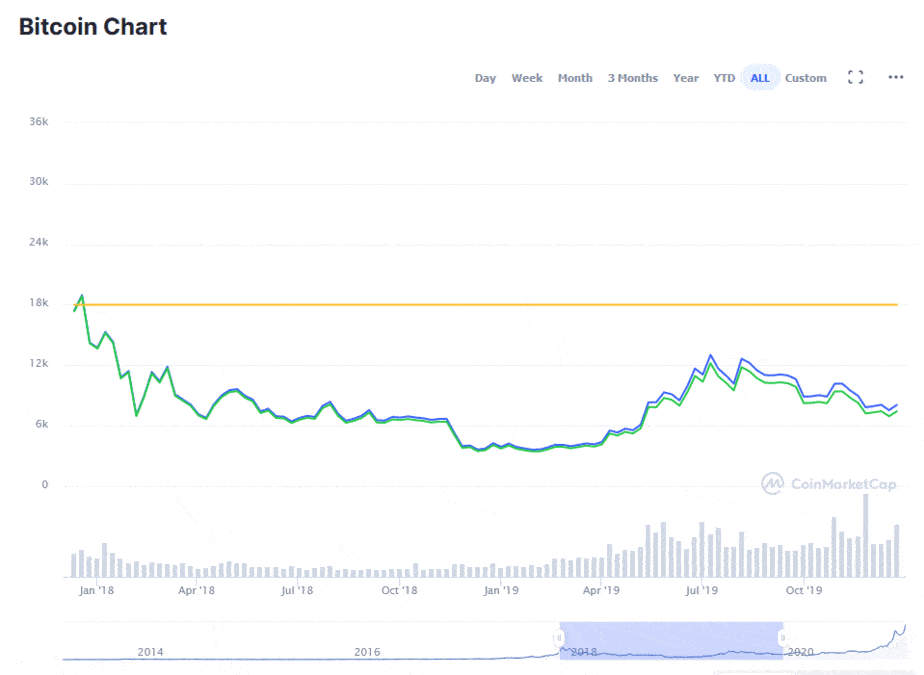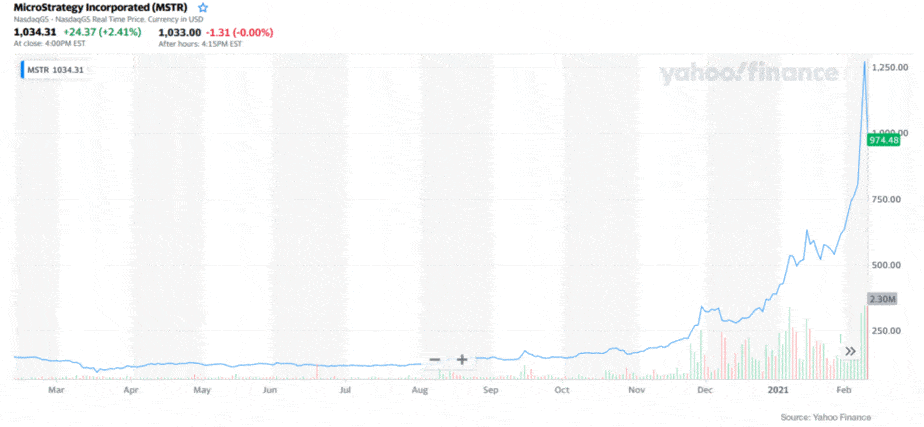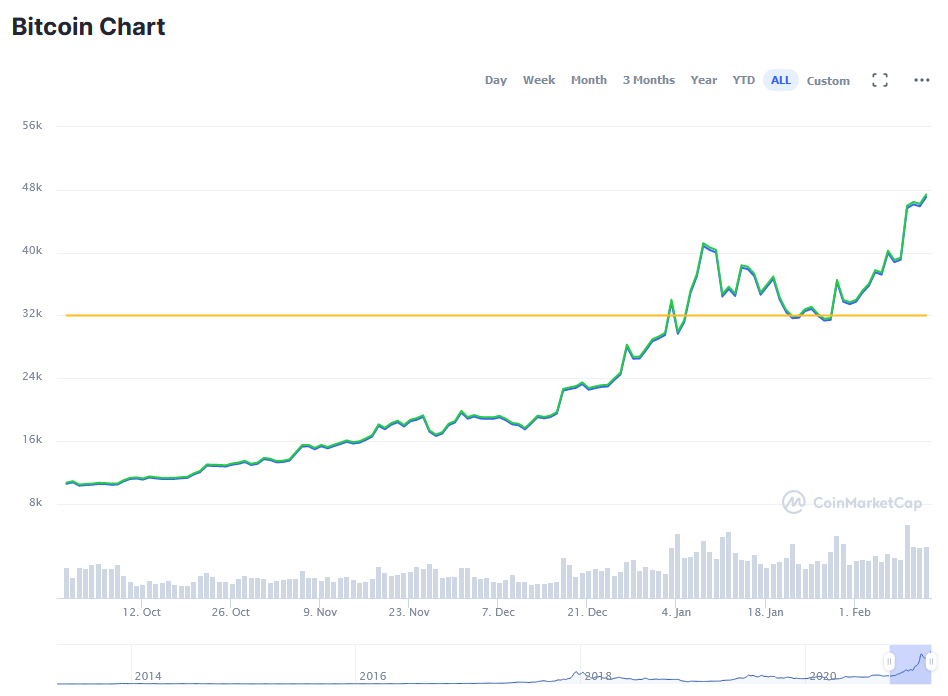Summary

Bitcoin (BTC) is on yet another bull run, but there’s something different this time. Previous cryptocurrency bull runs have been primarily driven by larger numbers of relatively small investors, but now the big fish are involved.
The first trickle of institutional capital is beginning to turn into a flood, and with Tesla Inc. (NASDAQ: TSLA) joining the fray, the crypto markets are primed to take off. The question on everyone's lips is whether institutional capital will be enough to light the fuse.
The last major bull run in 2017/2018 was punctuated by extreme skepticism from most institutional players. The most high-profile skeptic was undoubtedly JPMorgan Chase’s (NYSE: JPM) Jamie Dimon, who compared it to the “Tulip Bulb” scam.[1], [2] When the great crash hit in early 2018, many of these institutional players felt vindicated, and it appeared the Bitcoin bubble had burst for good.

Yet the Bitcoin project, and a whole slew of other cryptocurrencies, continued to thrive in relative obscurity. One year after the great crash, things began to change as innovations in Decentralized Finance (DeFi) apps injected new life into the crypto market, and by extension, Bitcoin.
DeFi apps leveraged smart contracts to provide traders with ways to access financial instruments without being forced to go through brokers. These included decentralized crypto exchanges such as UniSwap, but also collatoralless crypto loan services, such as those offered by AAVE. These innovative solutions helped to inject new excitement and capital into the crypto market over the course of 2019.
By June 2019, even JPMorgan had decided that BTC would survive as an asset class and in 2020 institutional capital finally began to take Bitcoin seriously.[3]
The first notable sign of change came from a business intelligence company called MicroStrategy Incorporated (NASDAQ: MSTR). In Q3 2020, the company acquired more than $425 million in BTC and by the end of 2020 the company had invested more than $1 billion in BTC. In just two months, the company’s gains from its BTC holdings had outpaced the $78 million in profits from MicroStrategy's last 3.5 years of operations.[4], [5], [6]

This bet might have been risky but it helped to catapult the company from a stock price of just above $125 at the beginning of 2020 to more than $1,000 in February 2021.
MicroStrategy was soon followed by a slew of household names including Massachusetts Mutual Life Insurance. However, one of the most significant players is the Grayscale Bitcoin Trust (OTCQX: GBTC). Over the course of 2020, Grayscale acquired more than $20 billion in Bitcoin assets. By January 2021, Grayscale had begun to cause a significant supply squeeze for BTC as it was buying up 3 times more BTC than miners could produce.[7]
The fund has proven enormously popular with institutional investors, who cannot necessarily buy BTC directly. Investments in GBTC grew 18 times from $500 million to a whopping $6 billion over the course of 2020.[8] Additionally the number of “whale” Bitcoin wallets, or wallets with more than $40 million in BTC, has been growing steadily over the course of 2020, implying increased interest from high-net-worth individuals and institutional operators.
Even the perception of institutional capital inflow has a significant positive effect on the price of BTC. For the majority of investors and traders, BTC is viewed as a speculative asset, but it is also designed to act as a store of value. With the capital backing of major players like GBTC, the capital behind BTC has stronger credibility, which theoretically justifies a much higher price.
This self-fulling prophecy can have a powerful effect, especially when you consider that most institutional investors haven’t invested in BTC yet. None of the top ten funds have invested in Bitcoin, and many hedge fund managers are still wary of the cryptocurrency.
Additionally, relatively few shops or companies currently accept Bitcoin as a form of payment. That could be about to change as PayPal (NASDAQ: PYPL) has promised that it will allow users to spend BTC within its network but for now, the utility of cryptocurrency outside of its own ecosystem remains limited.[9]
This means that BTC has likely not reached its potential yet. It also could mean that there is still a real opportunity for investors interested in Bitcoin to get in at a relatively early stage. To understand why, we can look no further than Tesla Inc. (NASDAQ: TSLA).
In early February, electric car manufacturer Tesla announced that it would be accepting payment in BTC, and that it had purchased around $1.5 billion worth of Bitcoin.[10] This announcement had an immediate positive effect on the price of BTC, sending it up to a new all time high of $47,000 on the day of the news.

This also led to a series of analysts significantly increasing their BTC price predictions for February. Many have estimated that BTC will hit $50,000 by the end of the month, and that Tesla’s announcement could lead to a slew of other companies and retailers accepting the digital currency as payment.[11]
Wider adoption would theoretically help to solve one of BTC’s biggest challenges: volatility.
In the previous two bull runs, BTC has reached new all-time highs only to plummet down to lows for extended periods. However, increased utility, combined with new capital inflow, could help to end that title and put BTC on a more sustainable course.
The most significant point to make here is that we are still in the early stage of Bitcoin’s growth. Risk-tolerant companies, like Tesla, have decided to embrace Bitcoin as a way to quickly provide shareholder capital, but the real money is still sitting on the sidelines.
Investors who decide to take a risk on Bitcoin now will have bought in before the likes of Blackrock Capital (NASDAQ: BKCC) finally make their move. While there is no guarantee of success, a move by any of the top 10 funds would likely dwarf the growth we’ve seen so far.
That being said, there are significant risks on the horizon which could change the picture.
While BTC is in a more comfortable position than at any other point in its history, there are challenges ahead. The two biggest existential threats to Bitcoin are technological and regulatory.
Regulatory Challenges

The best embodiment of the latter challenge comes in the form of President Biden’s pick for U.S. Treasury Secretary, Janet Yellen. Yellen has made the spurious argument that cryptocurrency is used “mainly for illicit financing,” a view that is shared by other influential regulators, including European Central Bank’s Christine Lagarde.[12]
Many Central Banks are concerned about BTC.
If these cryptocurrency-skeptic legislators were to make moves against BTC, it could make it significantly more difficult for investors, institutional or otherwise, to liquidate or even acquire BTC. This would have a significant negative impact on the entire cryptocurrency sector.
Thankfully, this challenge is easy to overcome with education. The cryptocurrency sector’s role in money laundering is minimal. It’s estimated that between $800 billion and $2 trillion is laundered each year. Just 0.34%, or $10 billion, of all crypto transactions were estimated to be related to money laundering in 2020.[13], [14] This means that at worst, crypto transactions make up just 1.25% of all money laundering globally.
Additionally, blockchain technology actually makes it harder to hide illicit transactions. Every transaction made on the BTC ledger is public, and impossible to change. If you know the identity of a wallet holder, it is possible to track every transaction they have made on the blockchain. This means that with sufficient Know Your Customer (KYC) checks, it should be possible to reduce the ability of bad actors to operate in the crypto space.
The other potential source of concern is the Securities and Exchange Commission (SEC). The US regulatory organization has recently targeted Ripple (XRP), arguing that the organization illegally raised funds. These kinds of investigations are unlikely to adversely impact Bitcoin, except in cases where it is used in lieu of a security.
Technological Challenges

Bitcoin’s big technical challenge at the moment is scalability. In order to prevent bad transactions, BTC relies upon a consensus method called Proof of Work (PoW). This involves large numbers of specialized computers, called miners, solving complicated puzzles in order to place a block of transactions on the blockchain.
Bitcoin is currently mined using specialized computers called ASICs.
This means that BTC can process transactions without relying on a central entity, but it is also slow and expensive. Bitcoin can process around 7 transactions a second. When there are large numbers of transactions happening simultaneously, this means that the network becomes clogged. This significantly slows transactions down, while concurrently increasing the cost as people compete to ensure that their transactions are placed on the blockchain next.
There are a few proposals on how to fix this:
The Lightning Network
The first is layer 2 solutions such as the Lightning Network. This solution is designed to connect two specific wallets so that they can interact with each other without interacting with the BTC blockchain. As long as the connection between the two wallets is open, they can send and receive BTC.
It is also possible for a closed network of connected wallets to interact with each other. For example if James has a wallet connected to Julie’s he can also send money to anyone Julie is connected with, and visa versa.
All transactions between the connected wallets act as a redistribution of funds. However these transactions will not be officially recorded on the BTC blockchain until the channel is closed. When the connection is closed, the initial and final balances of both wallets are compared, and recorded on the blockchain as a single transaction. This makes sending small amounts of BTC viable.
In order to prevent a double spend each party is given a penalty transaction. If one party attempts to spend their BTC without closing the connection, the other can broadcast their penalty transaction and if confirmed, gains access to all BTC in both wallets.
Proof of Stake
The other is a shift towards PoS (Proof of Stake). This is a consensus method that relies on users “locking” a portion of their assets in order to process transactions. It is currently used by a handful of projects, and the second largest cryptocurrency, Ethereum (ETH), is working on implementing a PoS system.
This would remove the need for miners, and provide a much cheaper way to process transactions. This would theoretically allow for far lower transaction fees, as there is no need for expensive specialized hardware in order to mine BTC.
At the moment, the cryptocurrency market is very interlinked. When the price of BTC increases, other cryptocurrencies tend to follow suit not long after. This is in part because BTC has the strongest name recognition in the cryptocurrency sector. It is also because BTC acts as a sort of “reserve” against which other cryptocurrencies are measured.

As Bitcoin continues to grow we are likely to see a new “Alt Season.” This is a cryptocurrency phenomenon where cryptocurrencies other than Bitcoin experience a significant spike in value. It typically follows alongside a BTC bull run.
There are a variety of other cryptocurrencies, collectively called Altcoins
Aside from Bitcoin, the other high potential cryptocurrency market segment is decentralized finance apps. We’ll go into these more in a future article, but these apps are designed to act as trustless versions of traditional financial instruments and services. The vast majority of these apps operate on the Ethereum blockchain, using the ERC20 protocol.
These projects, plus certain competitors to Ethereum such as Cardano (ADA), represent high-risk opportunities with strong growth potential. For example, the value of UniSwap (UNI), a popular DeFi crypto exchange, grew by more than 200% over the course of January 2021. A handful of other DeFi apps have shown similar success stories.[15]
The disadvantage of these tokens compared to Bitcoin primarily comes down to risk and liquidity. Bitcoin has shown itself to be surprisingly resilient, and as new capital continues to flow into the ecosystem, it is unlikely to experience a catastrophic failure. Investments in Altcoins could net investors much higher returns than BTC, but come with higher risks, including a complete loss of your investment.
There are a few ways that investors can get their hands on BTC, each with advantages and disadvantages:
For better or worse, Bitcoin will be the flagship of the cryptocurrency market for some time to come. It is also still the closest thing approaching a “safe” investment in the cryptocurrency space.
While more risk-tolerant institutional investors are beginning to make moves into the sector, it is still just the vanguard. This means that there is a window of opportunity for the rest of us to get in and ride their rocket to the moon.
I firmly believe that we are further witnessing the normalization of cryptocurrency, and that this represents a life-changing opportunity for many of us, but do your due diligence, and see if this opportunity is right for you.

Saul Bowden, Contributor
for Investors News Service
P.S. To discover more opportunities in the hottest sectors in North America, sign up now to the Financial News Now newsletter to get the latest updates and investment ideas directly in your inbox!
DISCLOSURE: Saul Bowden holds Ethereum, Bitcoin, UniSwap and other crypto assets.
DISCLAIMER: Investing in any securities, digital assets, digital securities, and digital money/currencies is highly speculative. Please be sure to always do your own due diligence before making any investment decisions. Read our full disclaimer here.
[1] https://www.bbc.com/news/business-51311368
[2]https://www.independent.co.uk/news/business/news/bitcoin-fraud-tulip-bulbs-jpmorgan-ceo-jamie-dimon-bank-investor-crypto-currency-a7943986.html
[3] https://www.coindesk.com/jpmorgan-analysts-bitcoin-is-likely-to-survive-as-a-speculative-asset
[4]https://cointelegraph.com/news/microstrategy-s-ceo-reveals-the-company-s-surprising-bitcoin-buying-strategy
[5]https://www.microstrategy.com/en/company/company-videos/microstrategy-announces-over-1b-in-total-bitcoin-purchases-in-2020
[6] https://news.bitcoin.com/microstrategy-ceo-million-bitcoin-btc-profit/
[7]https://cointelegraph.com/news/bitcoin-supply-squeeze-heats-up-as-grayscale-buys-nearly-3x-the-btc-mined-in-december
[8]https://www.forbes.com/sites/danrunkevicius/2021/01/14/myth-busted-wall-street-is-not-investing-in-bitcoin/?sh=693cb96f5510
[9]https://www.paypal.com/us/smarthelp/article/cryptocurrency-on-paypal-faq-faq4398?app=searchAutoComplete
[10] https://www.cnbc.com/2021/02/08/tesla-buys-1point5-billion-in-bitcoin.html
[11]https://www.independent.co.uk/life-style/gadgets-and-tech/bitcoin-price-prediction-cryptocurrency-tesla-b1799252.html
[12]https://markets.businessinsider.com/currencies/news/bitcoin-price-cryptocurrency-should-be-curtailed-terrorism-concerns-yellen-2021-1-1029985692
[13] https://www.tookitaki.ai/compliance_hub/50-statistics-on-money-laundering/
[14]https://blog.chainalysis.com/reports/2021-crypto-crime-report-intro-ransomware-scams-darknet-markets
[15] https://www.coingecko.com/en/coins/uniswap